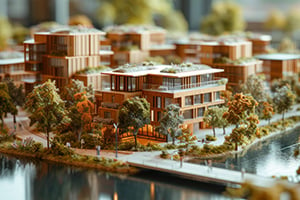
In large urban areas, the temperature is slightly higher than it is in less populated areas. This odd occurrence is known as the urban heat island effect. The lack of open areas and vegetation, combined with the prevalence of concrete and other construction materials lead to a situation where the exposed surfaces are heated by the sun and then radiate that heat back into the surrounding areas. Not only does this increase the average temperature during the day, but can also boost nighttime temperatures to over 22 degrees Fahrenheit higher than the average temperature found in rural areas. The urban heat island effect can result in dramatically increased utility bills as businesses and residences alike are forced to make extensive use of air conditioning. In addition, high temperatures can contribute to a variety of health hazards for the city’s population. These increased temperatures can be especially dangerous to the elderly and children.
Fortunately, there are a number of ways to reduce the impact of the heat island effect. One of the most effective methods currently in use is the installation of green roofs. A green roof replaces a traditional roof with a roof that incorporates a layer of vegetation.
Green roofs have several advantages. Firstly, they reduce the region’s ambient temperature. In fact, a green roof’s surface can actually be cooler than the ambient air temperature during the day and during the night, it will not radiate heat into the surrounding area. Additionally, green roofs help filter rainwater, eliminating the pollution that often results due to rainwater runoff from traditional roofing materials. Finally, they are more durable and have lower maintenance lifecycle costs than conventional roof designs.
Atlanta is an example of a city that is seeing an increasing number of buildings making use of green roof technology. For example, the Porsche Cars North American Headquarters and the Woodruff Arts Center are both examples of buildings that make use of an integrated green roof system. Additionally, the Atlanta City Hall green roof is an example of how a green roof can also see use as a rooftop garden or event area. Not only does this reduce the building’s heat burden, it also maximizes the building’s usable space. In all of these cases, the use of a green roof helps create a stylish exterior appearance in addition to combating the urban heat island effect.
By incorporating a green roof, a building not only improves the local city environment, but also incurs lower utility costs over its lifetime. For this reason, green roof technology is certain to continue to grow in popularity among an environmentally and budget conscious population.
© 2013 Sustainable Investment Group (SIG). All rights reserved.



